
Blitzkrieg or Bewegungskrieg is a word used to describe a combined arms surprise attack using a rapid, overwhelming force concentration that may consist of armored and motorized or mechanized infantry formations, together with artillery, air assault and close air support, with intent to break through the opponent's lines of defense, dislocate the defenders, unbalance the enemies by making it difficult to respond to the continuously changing front, and defeat them in a decisive Vernichtungsschlacht: a battle of annihilation.

Mechanized infantry are infantry units equipped with armored personnel carriers (APCs) or infantry fighting vehicles (IFVs) for transport and combat.

Combined arms is an approach to warfare that seeks to integrate different combat arms of a military to achieve mutually complementary effects—for example, using infantry and armour in an urban environment in which each supports the other.
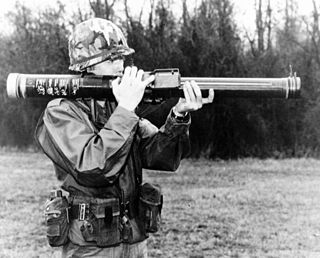
Anti-tank warfare originated from the need to develop technology and tactics to destroy tanks during World War I. Since the Allies deployed the first tanks in 1916, the German Empire developed the first anti-tank weapons. The first developed anti-tank weapon was a scaled-up bolt-action rifle, the Mauser 1918 T-Gewehr, that fired a 13.2 mm cartridge with a solid bullet that could penetrate the thin armor of tanks at that time and destroy the engine or ricochet inside, killing occupants. Because tanks represent an enemy's strong force projection on land, military strategists have incorporated anti-tank warfare into the doctrine of nearly every combat service since. The most predominant anti-tank weapons at the start of World War II in 1939 included the tank-mounted gun, anti-tank guns and anti-tank grenades used by the infantry, and ground-attack aircraft.

The Battle of Kasserine Pass took place from 18-24 February 1943 at Kasserine Pass, a 2-mile-wide (3.2 km) gap in the Grand Dorsal chain of the Atlas Mountains in west central Tunisia. It was a part of the Tunisian campaign of World War II.
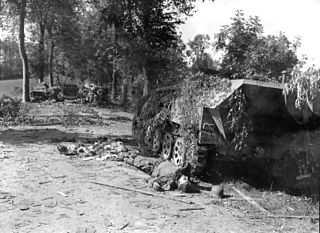
Operation Lüttich was the codename of the Nazi German counter-attack during the Battle of Normandy, which occurred near U.S. positions near Mortain, in northwestern France. Lüttich is the German name for the city of Liège, Belgium. In British and American histories of the Second World War, the German Operation Lüttich is known as the Mortain counter-attack, which Hitler ordered to regain territory gained by the First United States Army during Operation Cobra by reaching the coast of the Avranches region, which is at the base of the Cotentin peninsula, in order to isolate the units of the Third United States Army that had advanced into Brittany.

A counterattack is a tactic employed in response to an attack, with the term originating in "war games". The general objective is to negate or thwart the advantage gained by the enemy during attack, while the specific objectives typically seek to regain lost ground or destroy the attacking enemy.

The Battle of 73 Easting was fought on 26 February 1991, during the Gulf War, between Coalition armored forces and Iraqi armored forces. It was named for a UTM north–south coordinate line that was used as a phase line by Coalition forces to measure their progress through the desert. The battle was later described by Lt. John Mecca, a participant, as "the last great tank battle of the 20th century." This battle took place several hours after another, smaller, tank battle at Al Busayyah.
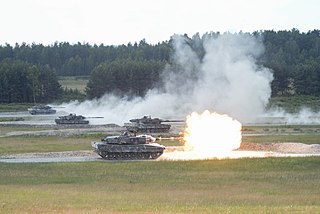
Armoured warfare or armored warfare, is the use of armoured fighting vehicles in modern warfare. It is a major component of modern methods of war. The premise of armoured warfare rests on the ability of troops to penetrate conventional defensive lines through use of manoeuvre by armoured units.
Deep operation, also known as Soviet Deep Battle, was a military theory developed by the Soviet Union for its armed forces during the 1920s and 1930s. It was a tenet that emphasized destroying, suppressing or disorganizing enemy forces not only at the line of contact but also throughout the depth of the battlefield.

Infantry tactics are the combination of military concepts and methods used by infantry to achieve tactical objectives during combat. The role of the infantry on the battlefield is, typically, to close with and engage the enemy, and hold territorial objectives; infantry tactics are the means by which this is achieved. Infantry commonly makes up the largest proportion of an army's fighting strength, and consequently often suffers the heaviest casualties. Throughout history, infantrymen have sought to minimise their losses in both attack and defence through effective tactics.

Fire and movement, or fire and maneuver, is the basic modern military low-level unit tactic used to maneuver on the battlefield in the presence of the enemy, especially when under fire. It involves heavy use of all available cover, and highly-coordinated exchanges of rapid movement by some elements of the squad or platoon while other elements cover this movement with suppression fire. It is used both to advance on enemy positions as part of an attack, or withdrawal from current positions under attack by the enemy. The moving and supporting (suppressing) elements may be teams or individuals, and may quickly and continuously exchange roles until the entire unit completes the maneuver objective. Some members will specialize more in different roles within fire and movement as fits their range, equipment, terrain, and ability to maneuver. This is usually applied to standard infantry tactics, but forms of this are also used with armored fighting vehicles or when supported by artillery or airpower.

For much of history, humans have used some form of cavalry for war and, as a result, cavalry tactics have evolved over time. Tactically, the main advantages of cavalry over infantry were greater mobility, a larger impact, and a higher riding position.

In military tactics, a flanking maneuver is a movement of an armed force around an enemy force's side, or flank, to achieve an advantageous position over it. Flanking is useful because a force's fighting strength is typically concentrated in its front, therefore, to circumvent an opposing force's front and attack its flank is to concentrate one's own offense in the area where the enemy is least able to concentrate defense.

Shock tactics, shock tactic, or shock attack is the name of an offensive maneuver which attempts to place the enemy under psychological pressure by a rapid and fully-committed advance with the aim of causing their combatants to retreat. The acceptance of a higher degree of risk to attain a decisive result is intrinsic to shock actions.

The Battle of Brody was a tank battle fought between the 1st Panzer Group's III Army Corps and XLVIII Army Corps (Motorized) and five mechanized corps of the Soviet 5th Army and 6th Army in the triangle formed by the towns of Dubno, Lutsk and Brody between 23 and 30 June 1941. It was one of the most intense armored engagements in the opening phase of Operation Barbarossa, and some say that it may surpass the more famous Battle of Prokhorovka. It is by far the battle with the largest number of tanks participating. It is known in Soviet historiography as one of the "border defensive battles". Although the Red Army formations inflicted heavy losses on the German forces, they were outmanoeuvred and suffered enormous losses in tanks. Poor Soviet logistics, German air supremacy and a total breakdown in Red Army command and control ensured victory for the Wehrmacht despite overwhelming Red Army numerical and technological superiority.

The tank destroyer battalion was a type of military unit used by the United States Army during World War II. The unit was organized in one of two different forms—a towed battalion equipped with anti-tank guns, or a mechanized battalion equipped with armored self-propelled guns. The tank destroyer units were formed in response to the German use of massed formations of armored vehicles units early in WWII. The tank destroyer concept envisioned the battalions acting as independent units that would respond at high speed to large enemy tank attacks. In this role, they would be attached in groups or brigades to corps or armies. In practice, they were usually individually attached to infantry divisions. Over one hundred battalions were formed, of which more than half saw combat service. The force was disbanded shortly after the end of the war when the concept had been shown to be militarily unsound.
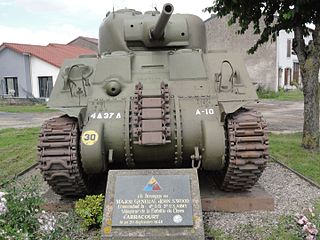
The Battle of Arracourt took place between U.S. and German armoured forces near the town of Arracourt, Lorraine, France between 18 and 29 September 1944, during the Lorraine Campaign of World War II. As part of a counteroffensive against recent U.S. advances in France, the German 5th Panzer Army had as its objective the recapture of Lunéville and the elimination of the XII Corps bridgehead over the Moselle River at Dieulouard.
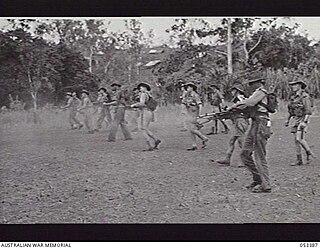
Marching fire, also known as walking fire, is a military tactic—a form of suppressive fire used during an infantry assault or combined arms assault. Advancing units fire their weapons without stopping to aim, in an attempt to pin down enemy defenders. Marching fire usually ends with an infantry charge to engage the enemy in close combat. The tactic requires ample ammunition and rapid-fire weapons. It differs from fire and movement in that the attacking force advances in unison rather than leapfrogging forward in alternating groups.
















